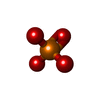[English] 日本語
 Yorodumi
Yorodumi- PDB-1gs4: Structural basis for the glucocorticoid response in a mutant huma... -
+ Open data
Open data
- Basic information
Basic information
| Entry | Database: PDB / ID: 1gs4 | |||||||||
|---|---|---|---|---|---|---|---|---|---|---|
| Title | Structural basis for the glucocorticoid response in a mutant human androgen receptor (ARccr) derived from an androgen-independent prostate cancer | |||||||||
 Components Components | ANDROGEN RECEPTOR | |||||||||
 Keywords Keywords | ANDROGEN RECEPTOR / HUMAN ANDROGEN RECEPTOR / LIGAND-BINDING DOMAIN / CORTISOL/ CORTISONE RESPONSE / PROSTATE CANCER | |||||||||
| Function / homology |  Function and homology information Function and homology informationmale somatic sex determination / prostate induction / lateral sprouting involved in mammary gland duct morphogenesis / male genitalia morphogenesis / regulation of developmental growth / POU domain binding / positive regulation of integrin biosynthetic process / tertiary branching involved in mammary gland duct morphogenesis / animal organ formation / androgen binding ...male somatic sex determination / prostate induction / lateral sprouting involved in mammary gland duct morphogenesis / male genitalia morphogenesis / regulation of developmental growth / POU domain binding / positive regulation of integrin biosynthetic process / tertiary branching involved in mammary gland duct morphogenesis / animal organ formation / androgen binding / cellular response to testosterone stimulus / regulation of systemic arterial blood pressure / Leydig cell differentiation / epithelial cell differentiation involved in prostate gland development / positive regulation of epithelial cell proliferation involved in prostate gland development / prostate gland epithelium morphogenesis / prostate gland growth / epithelial cell morphogenesis / membraneless organelle assembly / RNA polymerase II general transcription initiation factor binding / positive regulation of insulin-like growth factor receptor signaling pathway / positive regulation of transcription by RNA polymerase III / morphogenesis of an epithelial fold / cellular response to steroid hormone stimulus / positive regulation of intracellular estrogen receptor signaling pathway / androgen receptor signaling pathway / seminiferous tubule development / RUNX2 regulates osteoblast differentiation / nuclear steroid receptor activity / mammary gland alveolus development / cellular response to estrogen stimulus / estrogen response element binding / nuclear receptor-mediated steroid hormone signaling pathway / single fertilization / RNA polymerase II core promoter sequence-specific DNA binding / regulation of protein localization to plasma membrane / intracellular receptor signaling pathway / estrogen receptor signaling pathway / steroid binding / insulin-like growth factor receptor signaling pathway / HSP90 chaperone cycle for steroid hormone receptors (SHR) in the presence of ligand / epithelial cell proliferation / negative regulation of extrinsic apoptotic signaling pathway / RNA polymerase II transcription regulatory region sequence-specific DNA binding / positive regulation of cell differentiation / SUMOylation of intracellular receptors / molecular condensate scaffold activity / Activated PKN1 stimulates transcription of AR (androgen receptor) regulated genes KLK2 and KLK3 / beta-catenin binding / Nuclear Receptor transcription pathway / positive regulation of miRNA transcription / transcription coactivator binding / multicellular organism growth / male gonad development / nuclear receptor activity / negative regulation of epithelial cell proliferation / cell-cell signaling / MAPK cascade / ATPase binding / DNA-binding transcription activator activity, RNA polymerase II-specific / spermatogenesis / molecular adaptor activity / in utero embryonic development / RNA polymerase II-specific DNA-binding transcription factor binding / transcription by RNA polymerase II / DNA-binding transcription factor activity, RNA polymerase II-specific / transcription cis-regulatory region binding / positive regulation of MAPK cascade / Ub-specific processing proteases / nuclear speck / RNA polymerase II cis-regulatory region sequence-specific DNA binding / DNA-binding transcription factor activity / signaling receptor binding / negative regulation of cell population proliferation / positive regulation of cell population proliferation / chromatin binding / positive regulation of gene expression / chromatin / positive regulation of DNA-templated transcription / enzyme binding / negative regulation of transcription by RNA polymerase II / signal transduction / positive regulation of transcription by RNA polymerase II / protein-containing complex / zinc ion binding / nucleoplasm / nucleus / plasma membrane / cytoplasm / cytosol Similarity search - Function | |||||||||
| Biological species |  HOMO SAPIENS (human) HOMO SAPIENS (human) | |||||||||
| Method |  X-RAY DIFFRACTION / X-RAY DIFFRACTION /  SYNCHROTRON / SYNCHROTRON /  MOLECULAR REPLACEMENT / Resolution: 1.95 Å MOLECULAR REPLACEMENT / Resolution: 1.95 Å | |||||||||
 Authors Authors | Matias, P.M. / Carrondo, M.A. / Coelho, R. / Thomaz, M. / Zhao, X.-Y. / Wegg, A. / Crusius, K. / Egner, U. / Donner, P. | |||||||||
 Citation Citation |  Journal: J.Med.Chem. / Year: 2002 Journal: J.Med.Chem. / Year: 2002Title: Structural Basis for the Glucocorticoid Response in a Mutant Human Androgen Receptor (Ar(Ccr)) Derived from an Androgen-Independent Prostate Cancer Authors: Matias, P.M. / Carrondo, M.A. / Coelho, R. / Thomaz, M. / Zhao, X.-Y. / Wegg, A. / Crusius, K. / Egner, U. / Donner, P. | |||||||||
| History |
|
- Structure visualization
Structure visualization
| Structure viewer | Molecule:  Molmil Molmil Jmol/JSmol Jmol/JSmol |
|---|
- Downloads & links
Downloads & links
- Download
Download
| PDBx/mmCIF format |  1gs4.cif.gz 1gs4.cif.gz | 67.2 KB | Display |  PDBx/mmCIF format PDBx/mmCIF format |
|---|---|---|---|---|
| PDB format |  pdb1gs4.ent.gz pdb1gs4.ent.gz | 47.7 KB | Display |  PDB format PDB format |
| PDBx/mmJSON format |  1gs4.json.gz 1gs4.json.gz | Tree view |  PDBx/mmJSON format PDBx/mmJSON format | |
| Others |  Other downloads Other downloads |
-Validation report
| Summary document |  1gs4_validation.pdf.gz 1gs4_validation.pdf.gz | 734 KB | Display |  wwPDB validaton report wwPDB validaton report |
|---|---|---|---|---|
| Full document |  1gs4_full_validation.pdf.gz 1gs4_full_validation.pdf.gz | 739.8 KB | Display | |
| Data in XML |  1gs4_validation.xml.gz 1gs4_validation.xml.gz | 12.8 KB | Display | |
| Data in CIF |  1gs4_validation.cif.gz 1gs4_validation.cif.gz | 17.2 KB | Display | |
| Arichive directory |  https://data.pdbj.org/pub/pdb/validation_reports/gs/1gs4 https://data.pdbj.org/pub/pdb/validation_reports/gs/1gs4 ftp://data.pdbj.org/pub/pdb/validation_reports/gs/1gs4 ftp://data.pdbj.org/pub/pdb/validation_reports/gs/1gs4 | HTTPS FTP |
-Related structure data
| Related structure data |  1e3gS S: Starting model for refinement |
|---|---|
| Similar structure data |
- Links
Links
- Assembly
Assembly
| Deposited unit | 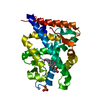
| ||||||||
|---|---|---|---|---|---|---|---|---|---|
| 1 |
| ||||||||
| Unit cell |
|
- Components
Components
| #1: Protein | Mass: 28939.934 Da / Num. of mol.: 1 / Fragment: LIGAND-BINDING DOMAIN, RESIDUES 670-917 / Mutation: YES Source method: isolated from a genetically manipulated source Source: (gene. exp.)  HOMO SAPIENS (human) / Production host: HOMO SAPIENS (human) / Production host:  |
|---|---|
| #2: Chemical | ChemComp-ZK5 / |
| #3: Chemical | ChemComp-PO4 / |
| #4: Water | ChemComp-HOH / |
| Compound details | ENGINEERED |
-Experimental details
-Experiment
| Experiment | Method:  X-RAY DIFFRACTION / Number of used crystals: 1 X-RAY DIFFRACTION / Number of used crystals: 1 |
|---|
- Sample preparation
Sample preparation
| Crystal | Density Matthews: 2.36 Å3/Da / Density % sol: 41.3 % | ||||||||||||||||||||||||||||||||||||||||||||||||||||||||||||||||||||||||||||||||||||
|---|---|---|---|---|---|---|---|---|---|---|---|---|---|---|---|---|---|---|---|---|---|---|---|---|---|---|---|---|---|---|---|---|---|---|---|---|---|---|---|---|---|---|---|---|---|---|---|---|---|---|---|---|---|---|---|---|---|---|---|---|---|---|---|---|---|---|---|---|---|---|---|---|---|---|---|---|---|---|---|---|---|---|---|---|---|
| Crystal grow | pH: 7.2 / Details: pH 7.20 | ||||||||||||||||||||||||||||||||||||||||||||||||||||||||||||||||||||||||||||||||||||
| Crystal grow | *PLUS Temperature: 20 ℃ / Method: vapor diffusion, sitting drop | ||||||||||||||||||||||||||||||||||||||||||||||||||||||||||||||||||||||||||||||||||||
| Components of the solutions | *PLUS
|
-Data collection
| Diffraction | Mean temperature: 100 K |
|---|---|
| Diffraction source | Source:  SYNCHROTRON / Site: SYNCHROTRON / Site:  ESRF ESRF  / Beamline: ID14-2 / Wavelength: 0.933 / Beamline: ID14-2 / Wavelength: 0.933 |
| Detector | Type: ADSC CCD / Detector: CCD / Date: Apr 15, 2001 / Details: TOROIDAL MIRRORS |
| Radiation | Monochromator: DIAMOND(111)+GE(220) / Protocol: SINGLE WAVELENGTH / Monochromatic (M) / Laue (L): M / Scattering type: x-ray |
| Radiation wavelength | Wavelength: 0.933 Å / Relative weight: 1 |
| Reflection | Resolution: 1.95→21.5 Å / Num. obs: 20504 / % possible obs: 100 % / Redundancy: 3.6 % / Rmerge(I) obs: 0.045 / Net I/σ(I): 18 |
| Reflection shell | Resolution: 1.95→2 Å / Redundancy: 3.6 % / Rmerge(I) obs: 0.266 / Mean I/σ(I) obs: 4 / % possible all: 100 |
| Reflection | *PLUS Num. obs: 20515 / % possible obs: 99.9 % / Num. measured all: 74323 |
| Reflection shell | *PLUS % possible obs: 100 % |
- Processing
Processing
| Software |
| |||||||||||||||||||||||||||||||||
|---|---|---|---|---|---|---|---|---|---|---|---|---|---|---|---|---|---|---|---|---|---|---|---|---|---|---|---|---|---|---|---|---|---|---|
| Refinement | Method to determine structure:  MOLECULAR REPLACEMENT MOLECULAR REPLACEMENTStarting model: PDB ENTRY 1E3G Resolution: 1.95→21.5 Å / Num. parameters: 8549 / Num. restraintsaints: 8331 / Cross valid method: THROUGHOUT / σ(F): 0 / Stereochemistry target values: ENGH AND HUBER
| |||||||||||||||||||||||||||||||||
| Solvent computation | Solvent model: MOEWS & KRETSINGER | |||||||||||||||||||||||||||||||||
| Refine analyze | Num. disordered residues: 1 / Occupancy sum non hydrogen: 2083 | |||||||||||||||||||||||||||||||||
| Refinement step | Cycle: LAST / Resolution: 1.95→21.5 Å
| |||||||||||||||||||||||||||||||||
| Refine LS restraints |
| |||||||||||||||||||||||||||||||||
| Software | *PLUS Name: SHELXL / Version: 97 / Classification: refinement | |||||||||||||||||||||||||||||||||
| Refinement | *PLUS % reflection Rfree: 5 % / Rfactor all: 0.205 / Rfactor obs: 0.197 | |||||||||||||||||||||||||||||||||
| Solvent computation | *PLUS | |||||||||||||||||||||||||||||||||
| Displacement parameters | *PLUS |
 Movie
Movie Controller
Controller



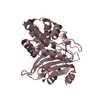

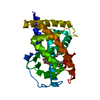

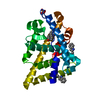
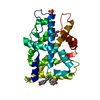
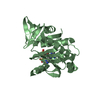
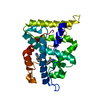
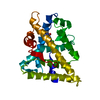
 PDBj
PDBj






